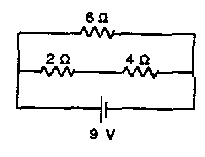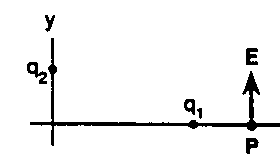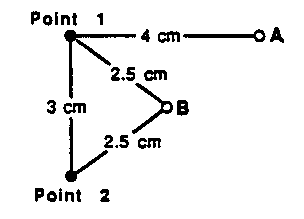Student Content Assessments
Instrument 1: Matching Questions from
Pre- and Post-Tests
Project: Introductory University Physics
Project (IUPP) — Phase III
American Institute of Physics
Funding Source: NSF: Course and Curriculum Development (DUE)
Purpose: To assess student knowledge of physics before
and after completing a course
Administered To: Physics students
Topics Covered:
- Content Specific Assessment: physics
Format/Length: 11 closed-ended multiple-choice
questions
Matching questions from Pre- and Post-Tests
(1.) On a beautiful winter's day a physicist becomes stranded
on the perfectly frictionless frozen surface of a lake. The
physicist is 50 feet from shore. A child who is passing by
on the shore throws a ball to the physicist. The child calls
out that the physicist should use conservation of momentum
to propel himself to shore. The physicist catches the ball
and finds himself propelled away from shore. To make
it back to shore the physicist should:
- Throw the ball back to shore with exactly the same speed
that it had when he caught it.
- Throw the ball back to shore with a speed that is greater
than it had when he caught it.
- Throw the ball away from shore with exactly the
same speed that it had when he caught it.
- Throw the ball away from shore with a speed that
is greater than it had when he caught it.
* * *
- Use the answer key just below to answer Questions 2
and 3.
A ball is tossed upward by a person standing on the surface
of the moon. It travels upward, reaches a maximum height above
its starting position, and falls back into the hand that tossed
it.
- Both an upward force and a downward force act on the ball.
The upward force is larger.
- Both an upward force and a downward force act on the ball.
The downward force is larger.
- Only an upward force acts on the ball.
- Only a downward force acts on the ball.
- The total force on the ball is zero.
(2.) Which one of the possibilities above best describes
the forces that act on the ball as it travels upward, after
it is no longer in contact with the hand that tossed it?
- [1 2 3 4 5]
(3.) Which one of the possibilities above best describes
the forces that act on the ball when it is at its maximum
height above its starting position?
- [1 2 3 4 5]
* * *
(4.) How does the kinetic energy of a car travelling at
60 miles per hour compare with the kinetic energy of the same
car when it travels at 20 miles per hour?
- The exact answer depends on the road conditions.
- It is 3/2 times as much.
- It is 3 times as much.
- It is 9 times as much.
- In order to answer this question one needs to know the
mass of the car.
* * *
(5.) The force of gravity is the primary force responsible
for the large scale structure of the Universe. Gravity binds
stars into large groups known as galaxies, and causes the
galaxies to cluster and form groups of galaxies. The reason
that the gravitational force plays a much larger role than
the electrostatic force on these large distance scales is
that:
- Gravity is the stronger of the two forces.
- The force of gravity becomes larger than the electrostatic
force at large distances.
- Mass always attracts other mass through the force of gravity,
but neutral matter does not experience an electrostatic
force.
- The electrostatic force is balanced by magnetic forces
for matter in motion, and most of the matter in the Universe
is in motion.
- The nuclear force, which plays a role in stellar burning,
must also be taken into account.
(6.) Consider the following hypothetical situation. A 1000
kg mass spontaneously decays into 2 pieces. One of the pieces
has a rest mass of 999.98 kg, and the other has a rest mass
of .01 kg. The amount of kinetic energy that is released in
the course of the decay:
- is significantly less than the rest energy of the smaller
mass.
- is approximately the same as the rest energy of the smaller
mass.
- is substantially greater than the rest energy of the smaller
mass.
- must be less than the speed of light.
- cannot be determined without measuring the velocities
of both masses.
* * *
Pre-Test version: A parachutist whose mass is 50
kg jumps from a plane that is moving parallel to the ground
(i.e., the plane has no upward or downward velocity). Since
she is a physicist and happens to have a good estimate of
the height of the plane, she is able to do a quick calculation
in her head and discovers that if the earth had no atmosphere,
she would be travelling at a deadly speed of 80 m/s by the
time she hit the ground. Fortunately the earth does have a
considerable atmosphere, and so, with the help of her parachute,
she achieves a final speed of only 5 m/s just before landing.
(When doing her calculation, she rounds off the acceleration
due to gravity to 10 m/s2.)
Post-Test version: A parachutist whose mass is 50
kg jumps from a hovering hot-air balloon. (You may assume
that the balloon is not moving relative to the surface of
the earth.) Since she is a physicist and happens to have a
good estimate of the height of the plane, (should say balloon...),
she is able to do a quick calculation in her head and discovers
that if the earth had no atmosphere, she would be travelling
at the deadly speed of 40 m/s by the time she hit the ground.
Fortunately the earth does have a considerable atmosphere,
and so, with the help of her parachute, she achieves a final
speed of only 5 m/s just before landing.
(question that has different answers on pre vs post-test:
Approximately how much energy was absorbed by the atmosphere?)
(7.) What probably happened to most of this energy?
- It was converted to gravitational potential energy.
- It was converted to chemical potential energy.
- It was converted to kinetic energy of the air molecules.
- It was converted to kinetic energy of the parachute.
- It was simply lost.
* * *

(8.) In the figure above, which resistors generate the least
and most heat per second, respectively?

* * *

(9.) A point electric charge of magnitude q1
is at rest on the x-axis as shown in the sketch. A second
point charge of magnitude q2 is at rest on the
y-axis at the point shown. At a point P on the x-axis beyond
the location of q1 the electric field vector produced
by these two charges points in the + y direction as shown.
From this information we know that:
- q1 is positive and q2 is positive.
- q1 is positive and q2 is negative.
- q1 is negative and q2 is negative.
- q1 is negative and q2 is positive.
- |q2| < |q1| but nothing can be deduced
about the sign of the charges.
* * *

(10.) When the partition is suddenly removed in the system
shown above, the ideal gas expands to fill the entire container.
During this expansion, we can be sure that
- the internal energy increased, and the entropy decreased.
- the internal energy decreased, and the entropy remained
constant.
- the internal energy remained constant, and the entropy
increased.
- the internal energy remained constant, and the entropy
decreased.
- both internal energy and entropy remained constant.
* * *

(11.) Point 1 is a point source of waves that have a wavelength
of 1 cm. Point 2 is a point source of identical waves that
are emitted in phase with the waves emitted by point 1. The
waves emitted by points 1 and 2 interfere:
- constructively at both points A and B.
- destructively at both points A and B.
- constructively at A and destructively at B.
- destructively at A and constructively at B.
- not at all because the sources are incoherent.
* * *
|

